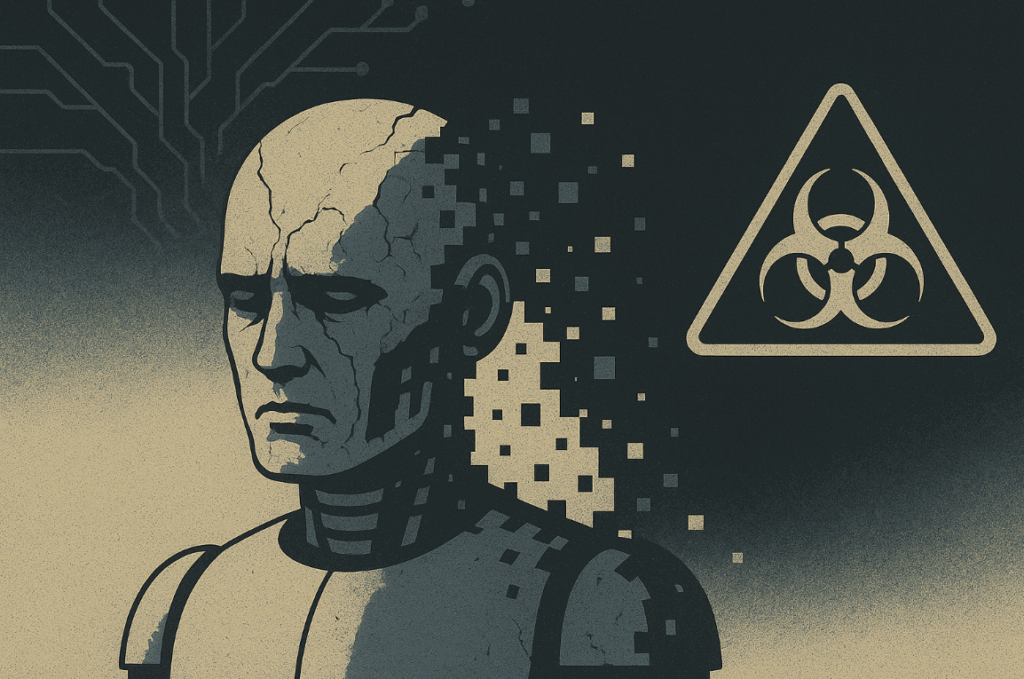AI Model Collapse & Data Poisoning
This lesson is currently in development and subject to change without notice.
This lesson explores the long-term vulnerabilities of generative AI systems, including the phenomena of model collapse, data poisoning, and the cascading risks of flawed training cycles. As AI models become increasingly foundational to digital infrastructure, understanding these failure points is critical to safeguarding future innovation.
What is AI Model Collapse?
Model Collapse refers to a critical degradation in the quality, creativity, and accuracy of a generative AI model due to repeated self-training or training on synthetic data that lacks meaningful diversity or truth anchors.
Some of the causes of AI model collapse:
- Synthetic Feedback Loops: When models are trained on data generated by earlier versions of themselves or other models, errors, hallucinations, and biases compound over generations.
- Loss of Signal: Repeated abstraction results in outputs that are statistically safe but semantically empty, often repeating tropes or patterns without innovation.
- Overfitting on Synthetic Norms: The model begins to favor popular or reinforced patterns rather than discovering new or accurate representations of reality.
- Overrepresentation Bias: Overrepresentation bias occurs when certain groups, features, or patterns dominate the training data, leading the AI model to perform disproportionately well on those groups while failing on others.
Impacts of model collapse:
- Lack of originality or creativity in outputs.
- Repetitive or overly generic results.
- Propagation of misinformation or subtle hallucinations.
- Reduced performance on real-world benchmarks or novel tasks.
What is Data Poisoning?
Data Poisoning is the deliberate or accidental insertion of corrupted, biased, or malicious data into training sets, with the intent to mislead or destabilize future AI outputs.
Types of Data Poisoning:
- Targeted Attacks: Inserting specific patterns that cause misclassification or behavior in certain edge cases (e.g., “Trojan triggers”).
- Gradient Manipulation: Influencing model weights during training through small, adversarial perturbations.
- Semantic Inversion: Feeding factually incorrect or manipulated content into large datasets (e.g., false historical facts or doctored images).
- Synthetic Pollution: Mass-producing low-quality AI-generated content on the web, which then gets scraped into future training datasets.
Impacts of Data Poisoning:
- Biased or unsafe model behavior.
- Erosion of trust in AI outputs.
- Potential weaponization of generative systems.
- Difficulty in attribution, audit, and redress.
The AI Doomsday Scenarios
The following are speculative but increasingly plausible scenarios if these issues go unmitigated:
Scenario 1: The Synthetic Collapse
AI systems primarily trained on data from previous or other AI systems can, over time, lose originality, nuance, and factual grounding. As the internet fills with AI content, which recursively trains more AI, causing exponential degradation, a creative and epistemic collapse.
Scenario 2: Poisoned Planet
Bad actors insert misleading or harmful data into the public corpus. Since AI systems scrape from this data blindly, misinformation becomes entrenched at a foundational level. Entire populations could be misinformed or manipulated through generated content that seems authoritative but is poisoned at the root.
Scenario 3: The Trust Singularity
As AI-generated content becomes indistinguishable from reality and sources become obfuscated, human society loses the ability to discern real from fake. Trust in institutions, media, science, and even identity itself erodes, resulting in a sociotechnical implosion.
Scenario 4: Black-Box Blindness
AI models become too large and complex to audit effectively. An undetected backdoor, adversarial patch, or misalignment in high-stakes systems (e.g., defense, finance) causes catastrophic, real-world consequences before human oversight can respond.
Mitigation Strategies
The following are a list of mitigation strategies to ensure the future viability and reliability of future AI systems.
- Data Provenance: Ensure datasets are traceable, verified, and labeled with source credibility. Open dataset initiatives can help with transparency and validation.
- Hybrid Training: Blend human-curated data with synthetic data and monitor drift regularly. Include real-world benchmarks to prevent collapse into synthetic sameness.
- Adversarial Testing: Routinely test models with adversarial prompts and inputs to probe for weaknesses and model misbehavior.
- Continuous Auditing: Establish tools and protocols for red-teaming, model explainability, and ethical oversight during development and deployment.
- AI Literacy: Educate users and stakeholders about the risks and realities of generative AI to foster critical thinking and responsible usage.
Personal Relevance and Experience
I have experienced a number of these issues personally when training data, even a large variety good data resulted in biased and overfitted camera view directions despite an overwhelming effort to overcome these issues. More data isn’t always better data, especially if it lacks necessary diversity. The capstone project, Project Quixote in this masterclass is a story I had begun in 2009, centering around model collapse and a world overdependent on fundamentally flawed AI models.
